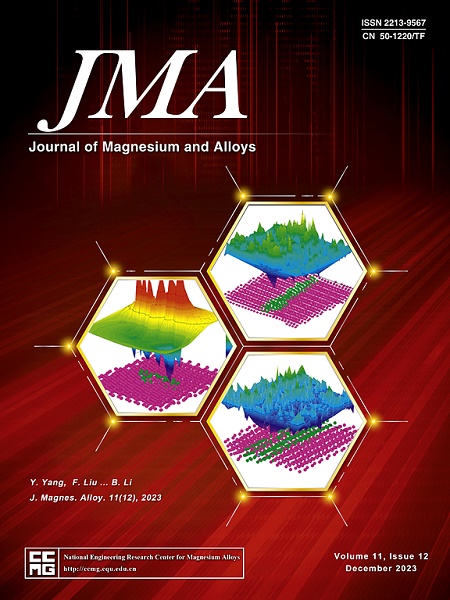In situ diffraction study on the annealing performance of a rapidly solidified ribbon consolidated Mg-Ca-Y-Zn-Mn alloy
IF 15.8
1区 材料科学
Q1 METALLURGY & METALLURGICAL ENGINEERING
引用次数: 0
Abstract
Dilute Mg alloys processed by the rapidly solidified ribbon consolidation (RSRC) technique are candidate materials for structural applications due to their enhanced mechanical performance. The thermal stability of the structure in these alloys strongly influences their mechanical performance at elevated temperatures. In this study, an RSRC-processed Mg–1% Ca–0.5% Zn–0.1% Y–0.03% Mn (at%) alloy was heated at a constant rate up to 833 K, and concurrently in situ X-ray diffraction (XRD) measurements were performed using synchrotron radiation in order to monitor the changes in the structure. In addition, ex situ electron microscopy investigations were carried out before and after annealing to complete the XRD study. On the basis of XRD results, the stages of the microstructure evolution during heating were identified. In addition, the thermal expansion coefficients of the matrix and the Mg2Ca secondary phase were determined. Between 299 and 400 K, the lattice constants of both the matrix and the Mg2Ca phase increased due to thermal expansion. In the temperature range of 400-673 K, the increase of the lattice constants with increasing the temperature continued, but their rate was different for the two phases which can induce thermal stresses. Between 673 and 753 K, the lattice constants of the secondary phase did not change most probably due to the compensating effects of the thermal expansion and the decrease of the Ca content. In the temperature range of 753–793 K, the Mg2Ca phase started to dissolve. Between 793 and 833 K the dissolution continued, and additionally the matrix was partially melted.


快速凝固带状固结Mg-Ca-Y-Zn-Mn合金退火性能的原位衍射研究
通过快速凝固带状固结(RSRC)技术加工的稀镁合金因其增强的力学性能而成为结构应用的候选材料。这些合金结构的热稳定性强烈地影响它们在高温下的机械性能。在本研究中,将rsrc处理的Mg-1 % ca - 0.5% zn - 0.1% Y-0.03 % Mn (at%)合金以恒定速率加热至833 K,同时使用同步辐射进行原位x射线衍射(XRD)测量以监测结构的变化。此外,在退火前后进行了非原位电镜观察,以完成XRD研究。根据XRD分析结果,确定了加热过程中微观结构的演变阶段。测定了基体和Mg2Ca二次相的热膨胀系数。在299 ~ 400 K之间,基体和Mg2Ca相的晶格常数均因热膨胀而增大。在400 ~ 673 K的温度范围内,随着温度的升高,两相的晶格常数继续升高,但升高的速率不同,从而引起热应力。在673 ~ 753 K之间,二次相的晶格常数没有变化,这很可能是由于热膨胀的补偿效应和Ca含量的降低。在753 ~ 793 K温度范围内,Mg2Ca相开始溶解。在793 ~ 833 K之间,溶解继续,并且基体部分熔化。
本文章由计算机程序翻译,如有差异,请以英文原文为准。
求助全文
约1分钟内获得全文
求助全文
来源期刊

Journal of Magnesium and Alloys
Engineering-Mechanics of Materials
CiteScore
20.20
自引率
14.80%
发文量
52
审稿时长
59 days
期刊介绍:
The Journal of Magnesium and Alloys serves as a global platform for both theoretical and experimental studies in magnesium science and engineering. It welcomes submissions investigating various scientific and engineering factors impacting the metallurgy, processing, microstructure, properties, and applications of magnesium and alloys. The journal covers all aspects of magnesium and alloy research, including raw materials, alloy casting, extrusion and deformation, corrosion and surface treatment, joining and machining, simulation and modeling, microstructure evolution and mechanical properties, new alloy development, magnesium-based composites, bio-materials and energy materials, applications, and recycling.
 求助内容:
求助内容: 应助结果提醒方式:
应助结果提醒方式:


